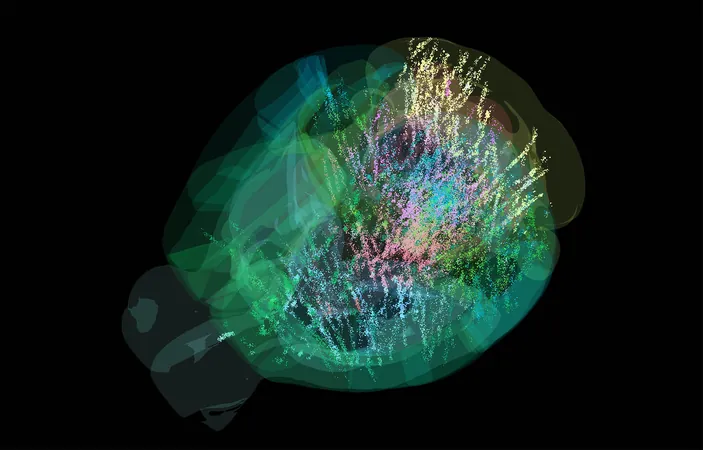
Revolutionary Brain Activity Map Unveils the Secrets of Decision-Making!
2025-09-13
Author: Ming
Groundbreaking Insights Into Brain Functionality
A revolutionary study has achieved a monumental feat: capturing brain activity from a staggering 621,733 neurons in 139 mice, ultimately creating the first detailed activity map of a mammal's brain at the level of individual cells. This innovative research sheds light on the elusive processes behind decision-making.
Mapping the Mind's Maze
Led by Alexandre Pouget from the University of Geneva, an international team of researchers trained mice to perform a task using a small wheel, aiming at a striped target for a reward. In scenarios where the target was faint or absent, the mice relied heavily on their recent experiences to make educated guesses.
To facilitate this monumental mapping, the researchers utilized 699 probes across 279 brain regions, deploying cutting-edge Neuropixels technology to capture neuron activity with unparalleled millisecond precision.
"This marks a historic moment—the first comprehensive, brain-wide map detailing single neuron activity during decision-making," Pouget proudly stated.
The Symphony of Brain Signals
The study revealed that visual signals emerged in traditional visual regions, then propagated to midbrain and hindbrain areas, where choice-related information also resided. Earlier research hinted at the distributed nature of choices, actions, and engagement, but this new map reinforces that theory through extensive coverage of hundreds of regions and precise timing.
The researchers also noted that feedback significantly influenced brain activity. During successful trials when rewards were administered, large portions of the brain were activated simultaneously, highlighting the connection between receiving rewards and corresponding movements.
How Expectations Shape Perception
In a related study, researchers investigated the role of past experiences on decision-making. Mice demonstrated the ability to estimate probabilities, performing remarkably well even under weak stimuli, including scenarios with no visibility.
The research decoded signals related to these expectations across 20 to 30 percent of recorded brain areas, encompassing key regions such as the thalamus, motor areas, and higher cortex. Intriguingly, these prior signals surfaced even before stimuli were introduced—indicating that expectations influence perception even before conscious awareness serves its part.
Decisions: A Collective Brain Effort
As the project developed, the researchers scrutinized a total of 75,708 isolated neurons, observing that when movement was about to happen, roughly 4 percent of neurons displayed activity correlating with the impending choice direction. Their analysis showed that action and outcome signals were widely shared, while sensory signals remained localized and brief.
This comprehensive brain mapping suggests that decision-making is not simply a transfer of information from sense to thought to action; rather, it appears that various regions collectively contribute to a decision, each providing partial insights that synchronize just before a choice is made.
Implications for Medicine and Technology
The significance of this activity map spans beyond academic curiosity; it holds valuable implications for medical science and technology. Understanding that choices and expectations are dispersed across the brain implies that targeting a single area may overlook broader narratives and could lead to unintended side effects elsewhere.
Nevertheless, this mapping is observational rather than causal, highlighting regions of activity rather than establishing definitive decision-making sites, setting the stage for future causal investigations.
The Path Ahead: Mapping Human Brain Activity
The study’s dataset is publicly available, along with standardized analysis code, empowering other research labs to validate findings, explore new models, and tackle questions regarding learning, attention, and cognitive states.
Next steps might involve merging this activity map with targeted interventions to track how expectations adjust across various contexts. If the brain's network principles apply universally, this could enhance our understanding of how probabilistic inference is executed within our minds.
This groundbreaking study is now published in Nature, promising to reshape our understanding of brain function and decision-making for years to come.


 Brasil (PT)
Brasil (PT)
 Canada (EN)
Canada (EN)
 Chile (ES)
Chile (ES)
 Česko (CS)
Česko (CS)
 대한민국 (KO)
대한민국 (KO)
 España (ES)
España (ES)
 France (FR)
France (FR)
 Hong Kong (EN)
Hong Kong (EN)
 Italia (IT)
Italia (IT)
 日本 (JA)
日本 (JA)
 Magyarország (HU)
Magyarország (HU)
 Norge (NO)
Norge (NO)
 Polska (PL)
Polska (PL)
 Schweiz (DE)
Schweiz (DE)
 Singapore (EN)
Singapore (EN)
 Sverige (SV)
Sverige (SV)
 Suomi (FI)
Suomi (FI)
 Türkiye (TR)
Türkiye (TR)
 الإمارات العربية المتحدة (AR)
الإمارات العربية المتحدة (AR)